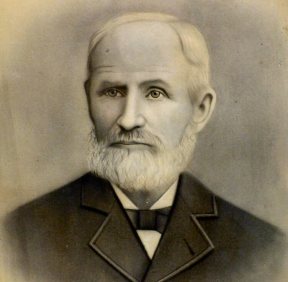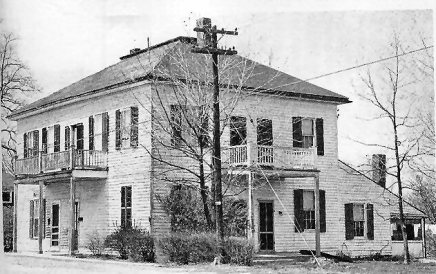Every human being has a story that should be told. Speaking a deceased person’s name acknowledges that a life mattered. Gone from this earthly plane, but not forgotten.
On Veterans’ Memorial Drive in O’Fallon, Missouri – next to the VFW Hall and across from Ethyl’s Smokehouse — sits a small, unpretentious graveyard. You won’t find massive ornate monuments in Sage Chapel Cemetery. In fact, a large majority of the graves are unmarked. Therein lay the remains of slaves and their families.

To appreciate the tales of the spirits of Sage Chapel Cemetery, it’s important to understand some of the area’s history. Two powerful and wealthy white families played central roles in this story: the kin of Samuel Keithley, Sr. and two Krekel brothers.
If not for Samuel Keithley migrating here from Kentucky in the early 1800s, Sage Chapel Cemetery would likely not exist. When he settled his large family here, he brought with him not only his slaves, but also those who were the property of other family members. By all accounts, he did not arrive here a wealthy man. He didn’t prosper right away, but within 40 years, the family owned hundreds of acres of land.

Known in the area as Uncle Sam, Keithley earned the respect of many of his neighbors through his generosity to the poor as well as his acts of kindness toward friends and strangers alike. But his charity extended only so far. During the Civil War a group of Union soldiers confiscated horses from some of his neighbors, telling them that “Uncle Sam” would pay for them. Imagine their disappointment and embarrassment when they went to Samuel Keithley requesting compensation and learned they had the wrong “Uncle Sam.”
When Congress granted Missouri statehood in 1820, slavery was already a topic of heated debate. The influx of German immigrants some ten to fifteen years later only served to intensify the tension. Along with them came the Krekel family. Arnold Krekel and his brother, Nicholas, became key players in founding O’Fallon. Like Keithley, it’s said that the Krekel family arrived in the area with few possessions and little wealth.

Arnold Krekel
But Arnold Krekel studied and worked hard to establish himself in St. Charles as an attorney, surveyor, and politician – among other pursuits. In 1855, he invested in 320 acres adjacent to the Keithley plantation. He platted out a town, naming it after John O’Fallon, the president of the Northern Missouri Railroad. Then he granted right-of-way through his property to that concern. As part of the deal, he arranged for his brother, Nicholas to be named station master and postmaster. So the younger brother left the farm where he’d been working and built a log cabin facing the tracks – later expanding and improving it. The Krekel House still stands today, the large two-story structure on the corner of Main Street and Civic Park Drive.

Nicholas Krekel
Shortly after the formation of the Confederate States of America, Nicholas Krekel joined the Union cause as a private in Company H of Missouri’s Home Guard. His brother, Arnold, served as the Company’s lieutenant colonel. As one might imagine, this did not set well with the slaveholding Keithley clan – especially since the Union soldiers known as Krekel’s Deutsch patrolled what is now Main Street, regularly marching up and down right in front of the Keithleys’ home.
One morning a member of the Keithley household noticed from an upstairs window as Krekel’s Deutsch paraded past once again. In an impulsive moment of wickedness, she threw open the window and yelled, “Hooray for Jeff Davis!” As the soldiers scrambled to see who had the nerve to say such a thing, the matron of the family came running to hush the thoughtless girl for fear that the furious Yankees might invade their home.
Fortunately, that didn’t happen. But does Krekel’s Deutsch continue patrolling? Some claim to hear the sound of boots echoing through the dark as the spectral squad marches along Main Street in the wee hours of the morning.

The Krekel House
As a border state, Missouri was exempt from President Lincoln’s 1863 Emancipation Proclamation, which only decreed the freedom of slaves in the territory claimed by the Confederacy. Not until two years later did a state constitutional convention vote to abolish slavery here. Arnold Krekel served as president of that body and signed Missouri’s Emancipation decree. On the same day, Governor Thomas Fletcher issued a Proclamation of Freedom, effectively ending legal slavery in the state. The key word here being “legal.” True liberty would evade the former slaves for more than a century.
Sixteen years after Missouri slaves were emancipated and 11 years after Samuel Keithley Sr. had passed away, his daughter, Mahala, and her husband, Jasper Costlio, transferred one acre of land, now Sage Chapel Cemetery, to the trustees of an African Methodist Episcopalian Church. This ensured that former slaves of the Keithley family could continue being buried there. The deed also conveyed a building and one-half acre of land along a dirt road that is now known as Sonderen Street. After selling ¼ acre of that land to a former slave, Liberty Abington, in order to settle their $150 Deed of Trust debt with the Costlios, the trustees established a church there – Sage Chapel. That church and two other black churches that eventually laid folks to rest in Sage Chapel Cemetery are long gone, as are their records.
It has been said that as long as a person’s name is spoken, their memory will live on. Sage Chapel Cemetery is the final resting place of slaves and their descendants, but it’s impossible to know all of their names because burials were taking place in that section of the Keithley Plantation long before the Civil War. There exists documentation of 117 interred there, but only 37 of the graves bear markers. At least 17 people buried there were both born into slavery and still living on Missouri’s Emancipation Day. Perhaps some haunt the area hoping their names will be spoken and their lives remembered.

Pricella Admire Ball’s headstone is so weathered that it is difficult to read. Born into slavery in Kentucky in 1811, her 89 years on this earth must have been difficult. Like many among the newly-emancipated, she and David Ball, who was born into slavery in Virginia, married in1866. Little more is known about her experiences, but the inscription on the monument makes clear that she bore at least one child. “Rest mother in quiet sleep…While friends sorrow….” The rest is illegible. Her only documented living relative at the time of her death was a grandson, David Clement, born in Kentucky many years after Samuel Keithley brought his slaves to Missouri. Whether Pricella was David’s maternal or paternal grandmother is unknown, but one thing is certain: Pricella’s child was sold at auction and left behind in Kentucky. It’s unknown if the two were ever reunited. Perhaps that sound we hear when we visit Pricella’s grave isn’t the wind in the trees after all. Could it be a mother whispering prayers for her long lost child?

The grave of Mishey Edwards, stepdaughter of Daneil H. Frost
Sage Chapel Cemetery is the final resting place of Daniel H. Frost, born into slavery in 1839. No monument adorns the grave of this man who served during the Civil War with the 2nd Missouri Colored Infantry, later designated U.S. Colored Troop 65, Company B. Research has not yet revealed how Daniel came to escape slavery to fight for freedom. After the death of his first wife, Daniel married Frances Rafferty Dryden, a former Keithley slave, in 1901. Both are buried in Sage Chapel Cemetery, both in unmarked graves. As is often the case with those born into slavery, this family’s genealogy is difficult to trace. Husbands often left widows who subsequently remarried. Daniel passed away in 1913, Frances survived until 1938. Cemetery records show that she left behind a daughter named Mishey Lechter Edwards who was born prior to her marriage to Daniel. Some say that a tall man in Union blue can sometimes be seen standing at attention in the graveyard. Is Daniel Frost paying tribute to Frances? Maybe. Perhaps he simply chooses to bloom where he was planted.

Lucy Hughes White was born enslaved on the Keithley Plantation in 1864. Lucy outlived three husbands – all of whom were also born into slavery. She bore seven children and raised several stepchildren who had survived their father. Lucy worked as a laundress and took in boarders to support herself, her children, and her grandchildren. The large, loving family lived in a log house on Lincoln Street. Her eldest son served as pastor to several African Methodist Episcopal Churches in St. Charles County and in California. Like his mother, the Reverend Fred Hughes lies at rest in the graveyard. Among the spirits of Sage Chapel Cemetery are others who bear the surnames of her brood: Claiborne, White, Lewis, and St. Claire. Despite the hardships she must have endured, much joy and happiness filled Lucy’s life as she helped her children and grandchildren grow and prosper under nominally better circumstances than she had experienced. During her final years, she lived with a daughter in Kinloch, Missouri until she came home to rest in Sage Chapel Cemetery. The maternal instincts of a hard-working, devoted woman like Lucy might extend beyond death. One might imagine her fussing over the graves of her descendants, making sure that they are comfortable and at peace.

Who else might be roaming that sacred ground? Perhaps the nameless souls whose existence has not been documented along with the enslaved people whose names we now speak.
Eldora Logan Abington, Liberty Abington, Frank Brady, Maria Brady, Martha Williams Burrell, Lucy Whitehead Claiborne, Mary Claiborne, Winston Davis, Frances Rafferty Dierker, Mary Stone Edwards, Alena Burrell Rafferty, John Rafferty, George Sanders, Okay Thomas, Mary Tucker, and Rufus White
Born into slavery; truly emancipated in death. May their souls rest in peace.
